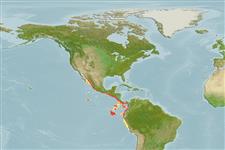Common names from other countries
Classification / Names / Names
Namen | Synonyme | Catalog of Fishes (gen., sp.) | ITIS | CoL | WoRMS
Environment: milieu / climate zone / depth range / distribution range
Ökologie
; tiefenbereich 73 - 1454 m (Ref. 101379). Tropical, preferred 23°C (Ref. 107945); 28°N - 17°S, 112°W - 72°W
Eastern Pacific: southeast Gulf of California, Mexico to Mollendo, Peru.
Distribution in Guatemala possibly true based on native range although no reference for Guatemala has been found yet.
Length at first maturity / Size / Gewicht / Alter
Maturity: Lm 11.7 range ? - ? cm Max length : 11.0 cm TL Männchen/unbestimmt; (Ref. 8)
Relatively common; trawled at depths of 73 to 760 m and caught at an even deeper water localities up to 1454 m (Ref. 101379).
Life cycle and mating behavior
Geschlechtsreife | Fortpflanzung | Ablaichen | Eier | Fecundity | Larven
Members of the order Decapoda are mostly gonochoric. Mating behavior: Precopulatory courtship ritual is common (through olfactory and tactile cues); usually indirect sperm transfer.
Holthuis, L.B. 1980. (Ref. 8)
IUCN Rote Liste Status (Ref. 130435)
CITES Status (Ref. 108899)
Not Evaluated
Not Evaluated
Nutzung durch Menschen
Fischereien: kommerziell
| FishSource | Sea Around Us
Tools
Mehr Information
Alter/GrößeWachstumLänge-GewichtLänge-LängeMorphologieLarvenDichte
Internet Quellen
Estimates based on models
Preferred temperature
(Ref.
115969): 6.7 - 11.9, mean 9.3 (based on 54 cells).
Widerstandsfähigkeit
hoch, Verdopplung der Population dauert weniger als 15 Monate. (K=0.41-0.86).
